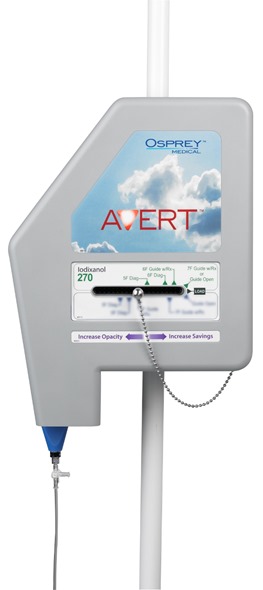
What kinds of dyes are commonly used in diagnostic heart procedures and why?
Iodine based contrast media (dye) is radiopaque and is commonly used for diagnostic and interventional heart procedures. It allows physicians to see real time images of the heart vessels and treat any blockages.
The iodine based dye is what is problematic for patients who have pre-existing kidney problems; their weakened kidney is not able to clear the iodine based dye.
Why is it beneficial to reduce the amount of dye patients are exposed to?
More than 25% of patients who undergo heart procedures are at risk of a harmful, even deadly, condition called Contrast Induced Nephropathy (CIN).
CIN is a form of kidney damage caused by toxic dye used in these procedures - the AVERT System is designed to reduce the amount of dye that is required for common heart procedures, thus safeguarding the kidney from the dyes negative effects.

Please can you give an introduction to the AVERT system? How does this system reduce the amount of dye injected in patients undergoing angiograms or diagnostic heart procedures?
AVERT is a dye reduction system which employs a pressure reducing system called a competence chamber to reduce the amount of dye injected and exposed to patients undergoing angiogram or diagnostic heart procedures.
In a pilot human clinical study, the AVERT System was shown to reduce the amount of dye by up to 40% without compromising image quality.
What stage of development is the AVERT System currently at?
In August this year, Osprey received approval from the FDA to commence a multi-site clinical trial to support its application for an expanded marketing claim for the AVERT System to include "CIN reduction".
Prior to this, the FDA had already cleared the AVERT System with the marketing claim of “controlled infusion of dye”.
This week, the Medical Leadership team was appointed for this randomized, multi-center, IDE trial, which will be enrolling approximately 700 patients at up to 45 sites in the U.S., Canada, Europe, Australia, and New Zealand.
Does reducing the amount of dye lead to a compromise in image quality?
In a pilot human clinical study, the AVERT System was shown to reduce the amount of dye by up to 40% without compromising image quality.
How do you think the future of diagnostic heart procedures will develop?
We feel the AVERT system will allow physicians to offer patients with poor kidney function an improved form of kidney protection while undergoing routine heart procedures.
For patients suffering from Chronic Kidney Disease we believe the AVERT system will become the new standard of care for CIN protection
What are Osprey Medical’s plans for the future?
We are excited about the prospects for the AVERT system to be commercialized worldwide following the completion of our AVERT randomized clinical trial.
In addition we are developing a Limb recovery technology that is currently in pivotal clinical trials in Australia. In a 5 patient pilot trial our limb recovery system was shown to help reduce the infection in the limb preventing amputation.
Where can readers find more information?
www.ospreymed.com
About Mike McCormick
 Mike McCormick was appointed President & CEO of Osprey Medical in March 2010. Mike has more than 20 years of experience in the medical device industry and president level experience with public and private medical device companies.
Mike McCormick was appointed President & CEO of Osprey Medical in March 2010. Mike has more than 20 years of experience in the medical device industry and president level experience with public and private medical device companies.
From 2003 to 2008, Mike was President and CEO of Anulex Technologies, Inc., a private company focused on developing proprietary technologies to support the healing of spinal soft tissues. Prior to this, Mike was President of Centerpulse Spine-Tech, a publicly traded full-line supplier of innovative spinal technologies with over 400 employees and US$125 million in annual revenues. Mike was involved in the successful sale of Centerpulse Inc. to Zimmer in 2003 for US$3.2 billion.
Early in his career, Mike worked at Boston Scientific Scimed for 10 years and Baxter Health Care where he served in a variety of sales and sales management roles. Mike received his Bachelor of Business Administration, Business Management from the University of Texas at Austin.
Mike is Chairman of the Board at OrthoCor Medical, Inc. a commercial stage private company in Minnesota and, is a member of the Board of Directors of Formae, Inc. a private company in the orthopaedics space.